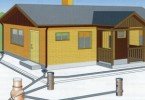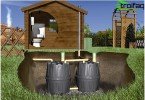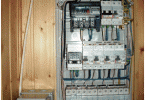Filter well
The treatment of domestic wastewater in a country house is a mandatory measure for their removal. At present, when the environmental issue is more relevant than ever, it must be remembered that the discharge of untreated sewage into the ground is prohibited. It is in connection with this that, after treatment facilities in suburban homes, underground filtering facilities should be provided. For the treatment of domestic wastewater, as a rule, various septic tanks are used, after which, according to the current sanitary standards, a filter well, sand and gravel filters, underground filtration fields or filter trenches are installed.
The choice of a building depends on:
- type of soil;
- groundwater depths;
- aquifer and other factors.
It is worth noting that for the biological treatment of wastewater, filter wells are currently most often used..
Content
- What is a filter well?
- Where to build a well for wastewater treatment?
- The device of this local treatment plant
- Bottom filter, backfill structure
- Walls of a well for a filtration
- Overlap and ventilation of the well
What is a filter well?
The filtering well is a special facility whose main purpose is the biological treatment of domestic wastewater in the local sewage system. The need for such a treatment plant is often due to the impossibility of draining sewage into any body of water through a drainage system.
As a rule, in such cases, the residential building is too far from the reservoir or the land is characterized by insufficient bias. That is why there is a need to drain waste water into the ground.
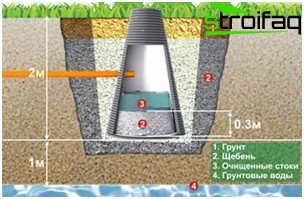
Filter well layout
Specialists note that filtering wells can act as an independent drainage structure or as an additional means for water treatment. In the first case, a well is installed on the site if the volume of wastewater does not exceed 1 m3 per day. In the second case, the well is used for the purification of wastewater before discharging them directly to the soil.
Where to build a well for wastewater treatment?
For the device of the filtering well it is necessary to carefully collect information about the soil. The fact is that you can build wells only on those soils that are suitable for filtering. These include peat, sandy soils and sandy loam with a low content of clay particles. As for clays and loams with a low filtration coefficient, the device of these structures in them is meaningless, since the filtration wells cannot be effectively operated.
Installation of wells for biological wastewater treatment in fractured rock is not allowed due to the fact that in this case there is no water filtration. However, in the absence of organized runoff, contaminated water can be released to drinking water sources. Therefore, in areas with soils characterized by low filtration properties, other methods of wastewater treatment are used.
In direct dependence on the state of the soil is the area of well filtration. For sandy soil, it can reach 3 m2, and for sandy loam – 1.5 m2. The filtration area, in turn, determines the period of operation of the well: the larger it is, the longer the life of the filter well.
Effective operation of the filtering well is achieved with its competent design, taking into account the depth of groundwater. Normal operation of the filtering well is ensured when the groundwater level is located below its filtering bottom by about 0.5 m. Moreover, the base of this drainage system should be 1 m above the groundwater level. If on the land plot where the country house is located, a sufficiently high level of groundwater, you will have to abandon the well for filtering.
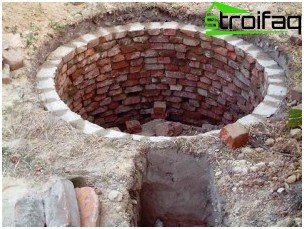
Well for wastewater filtration
Do not forget about the depth of freezing. The filtering well should be located below the level of soil freezing, which depends on the climatic conditions of a particular region of the country. So, in central Russia, it is about 1.3 m from the surface of the earth.
The device of this local treatment plant
The main elements of a well for wastewater filtration are:
- bottom filter;
- overlapping;
- the walls.
Bottom filter, backfill structure
Most often, the bottom filter is a well backfill made of gravel, gravel, sintered slag, brick fragments and similar materials.
The diameter of the fractions used varies in a rather wide range – 10-70 mm. This filling is most often carried out at a height of about 1 m.
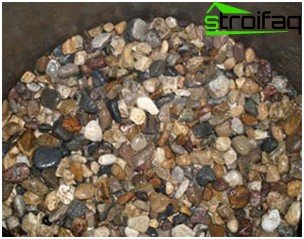
Gravel – bottom filter for filter wells
It is worth noting that purified water from suspended particles enters the well from the septic tank through a pipe, which should be located slightly above the surface of the filter. Most often, this distance is 0.2 m. The place where the jet falls on the bottom filter is covered by a special antiseptic shield that allows you to evenly distribute wastewater in the well. In addition, this measure helps prevent erosion of the filter backfill..
Walls of a well for a filtration
The walls of the well can be made of a variety of materials. It can be not only special reinforced concrete rings for the filtering well, but also an old barrel, solid clay brick or rubble stone.
Particular attention should be paid to the fact that holes must be left in the walls of the well or specially punched. They should be evenly distributed over the height of the bottom filter. As a rule, they are staggered and have a diameter of 4-6 cm. It should be noted that the area of all holes should not exceed 10% of the surface of the walls.
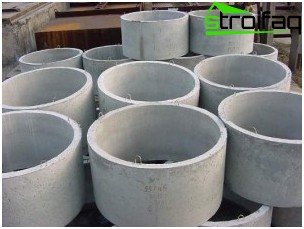
Reinforced concrete rings for filter wells
On the outside of the walls of the well filtering domestic wastewater, backfill is also carried out with the material used to lay the bottom filter. The filling height should be equal to the height of the filter, and the thickness is usually 30-50 cm.
Overlap and ventilation of the well
The filtering well, like the septic tank, must necessarily have a ventilation pipe. Its installation is carried out in the overlap of the treatment plant. At the same time, the top of the pipe should be located above the ground at a distance of about 70 cm, in addition, it should be equipped with such an element as a fly-gun.
It is believed that the optimal diameter of the ventilation pipe is 10 cm. Undoubtedly, a pipe sticking out above the ground can spoil the landscape, however, this problem can be solved without difficulty by masking the pipe with beautiful climbing plants.
In addition to the ventilation pipe, a hatch is installed in the well closure, the diameter of which most often reaches 70 cm. Its feature is the presence of two covers. The first of them is a carrier, the second is a weight and is located below. Between the covers it is necessary to leave a free distance, which is subsequently filled with one or another heat-insulating material. It can be standard mineral wool or perlite sand bags.
Currently, filter wells for treating domestic wastewater are rarely performed with a diameter of more than 2 m and a depth of more than 3 m. In the case when the area of this treatment plant is too large, it is recommended to arrange on the territory of the land plot not one large well, but several small ones. Such a need may arise, for example, with a well area of more than 4 m2 or with large volumes of wastewater. At the same time, do not forget that wastewater should be removed from an existing source of drinking water at a distance of at least 30 m.
Thus, the filter wells are a practical and functional element of the sewage system from a country house. A competent approach to their device will not harm the environment.



